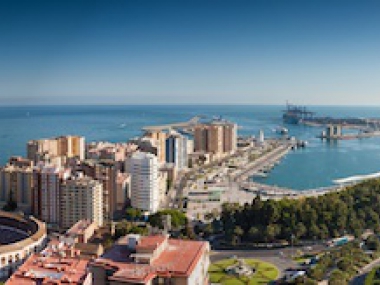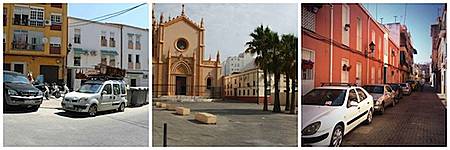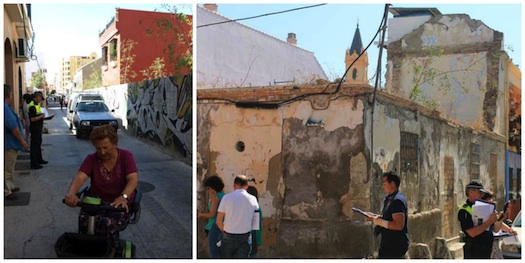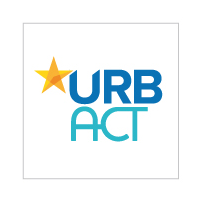Rebuilding Málaga on Community Power
Edited on
09 October 2017"Each city is like a different world," says Fernando Barreiro, Lead Expert of the USER network, "but there are many things they can learn from each other". Understanding this was precisely what made the active Spanish city of Málaga join a network with other cities across Europe, aiming to share knowledge and experience on how to engage citizens in the caretaking of their surroundings and, together with other stakeholders, the creation of better public spaces.

An ancient city under the sun
The history of Málaga, nowadays the sixth biggest city in Spain—home for more than half a million inhabitants—is quite a long one: it spans about 2,800 years, making it one of the oldest cities in the world. One after another, Phoenician, Roman, Arabic and Christian civilizations lived and thrived here, leaving a host of architectural monuments and a rich cultural heritage. Adding to its charm, the city lies by the Mediterranean, in the mild-weathered South of Spain, the so-called Costa del Sol —the Coast of the Sun. That name should give you a hint of its main industry: 84% of the economy is based on tourism, while the second most important sector is the construction industry. During the past few decades and after uncontrolled growth during the 70s and 80s, Málaga achieved a significant wealth of infrastructure and facilities: an international airport, a high speed train to Madrid and Barcelona, a port, the Andalusian Technological Park, a University, and so forth. Due to its strategic location between Europe and North Africa, and its moderate climate with an annual average temperature of 18ºC (70F), Málaga has attracted a large influx of investment, businesses and people over the past 20 years. However, this wonderful picture has some shadows within it: immigration and exclusion, deprived areas where only local residents would dare to enter, over-motorization of public spaces... and finally, like many other cities in Spain, it was hit hard by the financial crisis and the concomitant drop in the construction sector. In 2011 Málaga registered one of the highest rates of unemployment in the country - up to 30%!
Empowering communities through—and for—spatial regeneration
This is the situation of the adjacent neighbourhoods of 'La Trinidad' and 'El Perchel', separated from the central district only by the Guadalmedina River. The southern part of La Trinidad and the northern part of El Perchel are places where urban degradation and conflict have been living together with rich traditions and active social movements during the last few decades. With half of the 5.489 inhabitants lacking even a basic education, local economy is based on street trading and construction, and unemployment has scaled up to 40%.

View of one of the collective courtyards or 'corralones' – Image by USER Málaga
Already in 1994, a rehabilitation plan was established in order to improve these neighbourhoods. Since that time, some of the ageing buildings were replaced with new ones while maintaining the same urban structure. Typical configurations such as "corralones"—a kind of common courtyard with a mixed private-public character—were included in the new buildings along with a very successful scheme for user involvement. Neighbourhood communities began to take care of their buildings, keeping them clean, decorating them and even participating in feasts and competitions to show off their successes to fellow citizens and admiring visitors. Interestingly, some of the prizes did not consist of money, but rather materials and resources—like paint—to further improve their homes.
In 2004, a plan was established to take these efforts even farther, by creating a 'People's Museum District', in an attempt to capitalize on the renewed local traditions as a touristic value, while at the same time fostering social recovery. How could public space, in a context of social exclusion and conflict, be addressed and regenerated? How could residents feel the same sense of identification and belonging about the streets that they already felt about their courtyards? In order to achieve this, during the last decade actions have been taken which extend these experiences beyond the private buildings into the streets and squares around them.

Sample of the typical uses of public space in Trinidad-Perchel – Image by USER Málaga
The city was also looking for some fresh insight on other issues. For example, Trinidad-Perchel has many vacant lots scattered throughout the area like open wounds in its urban tissue. Most are used as informal parking lots, giving a very poor quality to the surrounding urban spaces. "We have been living with this conflict for a while now, but it cannot go on like this, it has to be addressed if we want to improve the overall conditions of the area", Begoña Oliva, local project coordinator of the USER network, admits.
Having taken part in an Spanish URBAN III project and a Strategic City Plan in relation to the historical centre and the recovery of the Guadalmedina River, Begoña Oliva already knew that "the important thing here would be to have the population take care of their immediate urban environment, and begin to make their own decisions".
After decades of intense urbanistic and social initiatives in the area, the leaders of the local regeneration project were quite ready to exchange experiences and knowledge with others. So when the Agglomeration of Grenoble contacted them, joining a collaboration network felt like the obvious step to take.
USER – Changes and conflicts in using public spaces
A core USER idea is that the design of urban public spaces and the main goals of urban planning are challenged by rapid changes in how cities are used.
Project aims are to be found in three areas:
• Friendlier and more interactive social-public spaces by solving malfunctions and conflicting uses.
• Safer public spaces in a friendlier city.
• Cleaner, better-maintained and upgraded public spaces for a more efficient city.
Lead partner: Agglomeration Grenoble Alpes Metropole (France)
Partners: Copenhagen (Denmark), Cracow (Poland), Dresden (Germany), Lublin (Poland), Lisbon (Portugal), Málaga (Spain), Pescara (Italy), Riga (Latvia)
Duration: May 2012 – Mid 2015 (ongoing)
Link to the project: urbact.eu/user

Lessons in the bridge between the global and the local
So URBACT came to town, and with it came one of the biggest challenges URBACT networks have to face: connecting the transnational exchange with local projects and making them work together. As Fernando Barreiro summarizes: "At the beginning of the project there was some confusion on how to gear local activities to the transnational dynamics of URBACT. They expected to connect the whole Integrated Plan for Trinidad-Perchel to it, but in the end realized that USER would best cover a specific aspect: public space regeneration. Beyond that tipping point, everything was much easier". There was much to be shared and to be learned. Begoña Oliva explains some of their findings: "Among the most appreciated transnational activities are the field visits, especially when they are led by local inhabitants. You walk around a foreign city, and while the first impressions are based on the differences, after a while you begin to see similarities, affinities and things you could really take back to your own context. I remember walking around Copenhagen and thinking: These people really know how to make themselves at home in public space." Cristóbal Gil, Head of the Social Centre of the Trinidad-Perchel district and ULSG coordinator for USER in Málaga, expresses a warm feeling about it: "Visiting other cities helps us understand that our reality is not so bad nor so impossible to deal with". A similar method learned from Grenoble, the 'walking diagnostic', has been one of the most useful tools they have been able to adapt from the transnational network: a selected group of stakeholders—including neighbours, technicians, police, professors and even school children, among others— walk around the target area, identifying specific aspects and issues related to public space. This methodology has even proved itself capable of bypassing the sometimes complicated relationship between the regional and local government. "We were walking around San Pablo Square, discussing the excess of cars occupying the public space, and suddenly an architect told us that, indeed, there was a public underground parking lot below our feet, half-built by the Andalusian regional government", says Begoña Oliva, and continues: "Without that walk, we would not have even known it was there! Of course, we started a conversation with the 'Junta de Andalucía' right away."

Walking diagnostic around the area – Image by USER Málaga
The thematic workshops held in turns in different cities with the corresponding 'perception report' delivered by the visiting partners, have also turned out to be a very valuable source of feedback and fresh ideas, helping them to go beyond their local mindset. So far they have built common indicators and methods for diagnosis, expanded their definition of 'public' space, discussed some shared concerns, and even exchanged people across the network.
There are, of course, some issues. Language, as a cultural barrier, is sometimes one of them. The difficulty to articulate the different agendas and timeframes between the local project and the URBACT network is another. But these issues are worth dealing with!
Reformatting participatory structures and methods
As previously mentioned, social involvement was already a common dynamic in the area. But still, the Local Support Group, as an infrastructure for participation, was something new to them. "They had been working with more open assemblies, but the idea of a focused, efficient and action-oriented stakeholder group was quite new", Barreiro explains.
That did not put anyone off though, as Begoña Oliva tells us: "Even while being a foreign structure, the reaction to the ULSG has been amazing. We have received a lot of support from the local community, with more than 100 people of all ages actively participating in the plenary sessions. They have really taken this as an instrument for everyone to work towards our common goals! And while we have some particular interests popping up every now and then, in general they do understand the scope and limits of this group, helping us to keep it focused." Furthermore, as she enthusiastically explains, it has been welcome not only by citizens: "There is even over-representation from the Municipality! We always have officials and technicians from many different areas, including the Major, attending the meetings".
The group now includes a great mix of practitioners, local associations representatives and some popular—and peculiar—characters from the area. And, as Begoña insists, "a representative of almost every department in the Municipality", allowing the project to adopt a truly integrated approach.
Ciro de la Torre, architect and professor at the University of Málaga (UMA), tells us more about it: "It was a rewarding experience, it brought us all closer together". As part of the ULSG, he feels he was able to explain things that others did not understand in the first place and, in return, they made him see things he had not seen before. "I have designed and built several social housing blocks and some other important buildings in this very neighbourhood," he says, "trying to make the best spaces for the people... but without the people! Cristóbal and others from the local Social Centre, on the other hand, have been building mainly with people —instead of bricks. That has allowed me to understand why some great buildings and infrastructures are barely appreciated while some low quality ones show a great social success and a caring community around them".

One of the meetings of the URBACT Local Support Group – Image by USER Málaga
Cristóbal Gil, together with María Dolores Alcarazo, Social Services Technician in the Historic District and ULSG members, summarize some of the advantages they have found in the ULSG so far: "It turns out to be a very interesting self-education space on participatory processes for the transformation of urban spaces and their social dynamics. It also allows us to get in one place the joined inputs of social technicians, urban planners and many other profiles across the different areas of the Municipality, who, at the same time, are getting to know the area better than ever before".
The future is to be written... with the same social ink
The project is still in the implementation phase, half-way developed, but some actions have already been taken in with a relatively low investment—around 150.000€—from the Municipality. This acted as a first devolution to the participatory process as itallowed neighbours to see some results and enjoy tangible improvements without a long wait. "They are really happy with what has been done so far, for example, about the lighting in some areas", Begoña Oliva says.
María Dolores Alcarazo explains how "during the following months the challenge will be building a consensual and feasible proposal on the regeneration of public spaces, and designing a Local Action Plan—already being drafted—with a global perspective for Trinidad-Perchel".
The participants already envision the ULSG as a structure that will continue across the next stages of the project, including its involvement in some pilot projects as part of the forthcoming Integrated Operational Programmes. As Cristóbal Gil clearly expresses it: "Of course, it has to be that way! The ULSG needs to keep its role active through the implementation and follow-up phases of the project, until the final goal is achieved. And even then, once we have a successful public space, it will not be a static picture: new issues, needs and uses will emerge, and the continued involvement of key stakeholders will still be essential to keep the spaces alive and in line with their context".
Meanwhile, far away in another part of town…
At this point, one would think that connecting one URBACT project with the local plans was enough of a challenge for a city. Not so for Málaga!
They took a bet on URBACT, as they joined not only one, but two networks at the same time. Long story short: two independent local projects, working with a similar approach in different parts of the same city... almost only linked by a transnational European programme!
RE-Block – Reviving high-rise Blocks for cohesive and green neighbourhoods.
The main objective addressed by RE-Block is to foster the efficient regeneration of these neighborhoods, making them more attractive and improving their environmental quality, whilst creating an integrated tailor-made approach to combat poverty.
Lead partner: Budapest XVIII District (Hungary)
Partners: Rome (Italy), SalfordUnited (Kingdom), Södertalje (Sweden), Magdeburg (Germany), Vilnius (Lithuania), Komotini (Greece), Iasi (Romania), Gelsenkirchen (Germany), Málaga (Spain)
Link to the project: urbact.eu/re-block

Placed in Palma Palmilla district, the 'La Palma' neighbourhood consists of several high-rise building blocks which, over the past few decades, have acquired a bad reputation across the whole city. As in the case of Trinidad-Perchel, a plan was established in 2005 to bring hope and some perspective to the residents, and a similar 'marriage' between existing—and very inspiring!—participatory experiences and the ULSG format proposed by the URBACT Re-Block network is taking place here.
This other experience truly deserves to be explored, but perhaps, as the German writer Michael Ende once said, "this is another story and shall be told another time".
Photo credits top image : Paolo Trabattoni on flickr
Read more :
User network – URBACT website
RE-Block network – URBACT website
 Submitted by URBACT on
Submitted by URBACT on




